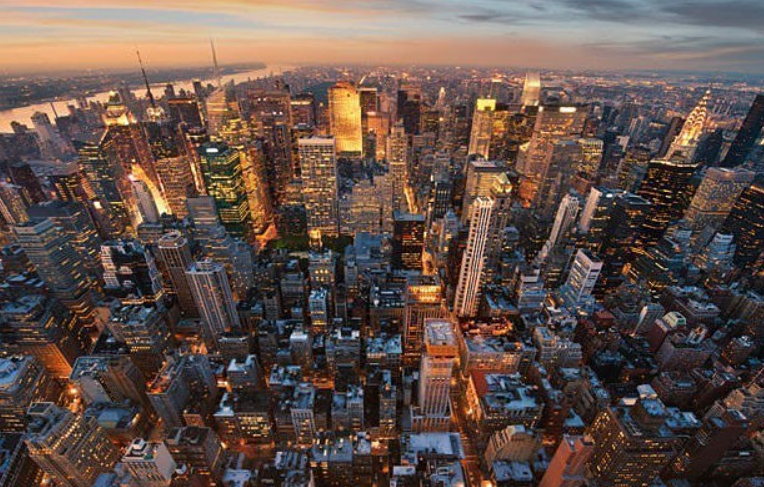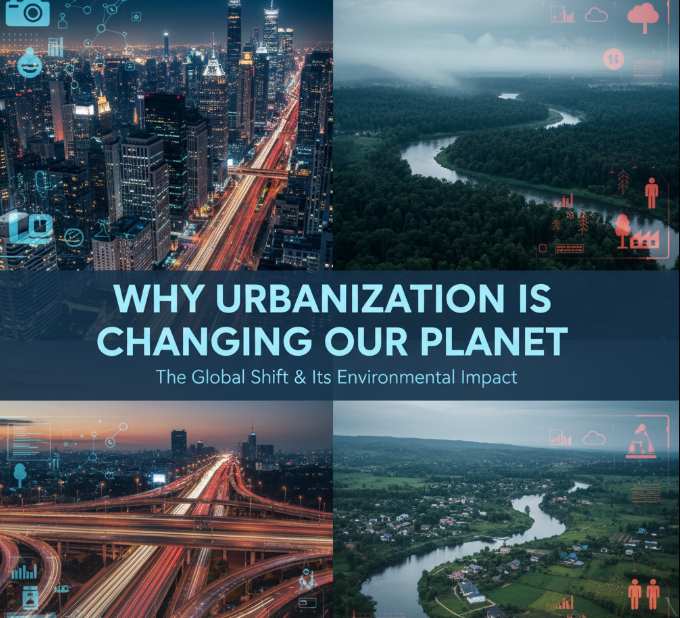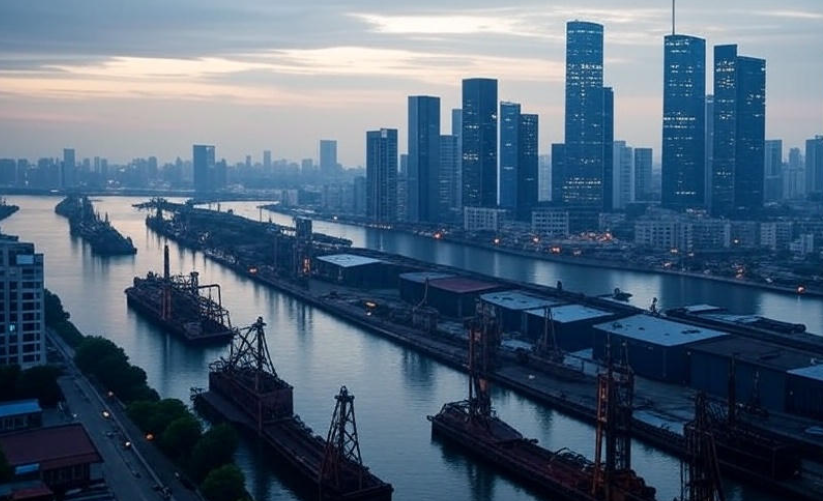There are three people moving from a rural to an urban area somewhere in the world every second. That’s something like 180 people per minute, or more than a quarter million every day. This great reshaping of how humans live is one of the most sweeping changes our planet has ever undergone — and it’s happening in our lifetimes.
Farm land is vanishing into cities at an astonishing rate. The natural habitat is being turned into concrete and asphalt. The very way we live, work and relate to the nature of that planet is radically changing. But urbanization is not just about more buildings and crowded streets. It is remaking our climate, our ecosystems, our economy and even the rhythm of how we think about spending time on our planet.
This shift toward urbanization has brought extraordinary opportunities and enormous challenges. Learning what urbanization does to our planet makes us wiser about the world we wish to inhabit tomorrow.
The Race to Cities: What’s Really Happening
In 1950, just 30 percent of humanity was urban. Today, that proportion has soared to around 56%, and experts predict it will rise to 68% by 2050. That’s about 2.5 billion more people who’ll be leaning on cities within the next few decades.
This isn’t happening evenly everywhere. Cities in North America and Europe grew steadily for more than a century. But the high drama is in Asia and Africa, where cities are growing at a breakneck pace. Lagos, Nigeria, grows by an estimated 3,000 residents a day. New York added 375,000 people from 2010 to 2019. The Indian metropolis of Delhi is growing by nearly 500,000 people a year — equivalent to adding a city the size of Liverpool every year.
There are a number of forces behind this urban migration. Young people flee rural areas for better jobs and higher wages. Families want access to good schools and hospitals. Farmers face unreliable weather and failed crops, driving them toward the city. On the other hand, cities offer entertainment, diversity and opportunity that small towns can’t compare to.
How Cities Reshape the Physical World
Eating Up Natural Spaces
Urban sprawl consumes some 200,000 square kilometers of naturally vegetated land each decade — that’s approximately the extent of Nebraska. Forests become parking lots. Wetlands turn into shopping malls. Grasslands disappear under housing developments.
This transformation of the land has an impact far beyond the immediate area. As cities grow, they divide up natural habitats and isolate wildlife populations from food, water sources and breeding sites. To a human, a highway cutting through a forest may not seem like much, but if you are a deer or bear it is an impossible-to-cross barrier that forever divides your habitat.
Agricultural land faces particular pressure. The world’s most fertile soils are typically found near cities, because those flat, well-watered areas where great crops grow also provide a good place to build. China is losing about 2,400 square kilometers of farmland a year to urbanization, sparking concerns about the future of its food security.
The Heat Island Effect
Stand in a downtown amid traffic, on a scorching summer afternoon, then drive 10 minutes into the countryside. You can almost instantly feel the change in temperature. Cities can be 5 to 7 degrees Celsius warmer than the surrounding countryside — a phenomenon known as the urban heat island effect.
Why does this happen? Surfaces that are dark, such as asphalt and tar roofs, absorb heat and trap it. Buildings block cooling winds. Air conditioners push hot air outside. Vehicles emit engine heat. Meanwhile, all that lost vegetation — which offered shade and cooling through evaporation — is now absent.
This extra warmth causes major problems. For city dwellers, heat waves can become lethal — and deadly — particularly to older residents and those who don’t have air-conditioning. Everyone runs the AC at full blast, leading to skyrocketing energy bills and making it even hotter outside. The additional heat can even lead to change in local weather patterns, causing more extreme thunderstorms at times.
Urbanization’s Impact on Water Systems
Where Does All the Rain Go?
Natural areas are surface-level sponges. Rain that falls on forests or grasslands instead soaks into the ground, with soil capturing much of the water and releasing it slowly to streams and recharging underground aquifers. But cities turn that system on its head.
Concrete and asphalt are waterproof. When rain falls on cities, roughly 55% of it zooms, unaltered, into storm drains — while the rate in natural areas is just 10%. This creates two major problems.
First of all, that runoff creates flooding. Water that would typically be absorbed into the ground flows instead onto streets and into basements. Cities around the world are spending billions of dollars to re-engineer themselves with bigger storm drains, more flood walls, landscaped greenways and other strategies that can move urban flooding downstream.
Second, this fast runoff leaves less water to seep into the ground and replenish underground water supplies. In many cities, underground water is pumped out more quickly than rain can refill it, and the result is that wells are running dry and the ground in those areas is sinking — a problem affecting everywhere from Jakarta to Mexico City.
Pollution Flows Downstream
That runoff doesn’t travel alone. As stormwater races across parched parking lots and streets, it scoops up oil, trash, fertilizers, pet waste and a billion other bits of human detritus — sending this soiled effluent straight into rivers and oceans.
At the same time, cities create vast volumes of sewage. A city of 1 million inhabitants generates approximately 150 million liters of wastewater per day. In affluent countries, treatment plants clean much of this water before it is discharged. But in many developing cities, raw sewage is dumped directly into rivers, transforming the waterways into open sewers and spreading diseases like cholera and typhoid.

Air Quality and Urban Atmosphere
Cities have a different kind of breathing from the countryside. Engines, factories and heating systems spew millions of tons of pollutants into the urban air each day. The World Health Organization says nine out of 10 people in cities breathe unhealthy air.
Smog — the brownish haze you see hanging over cities — is created when sunlight interacts with vehicle exhaust and industrial emissions. This toxic stew irritates the lungs, causes asthma attacks and raises the risk of heart disease. In cities with exceptionally poor air, such as New Delhi and Beijing, breathing the air on a bad day is analogous to smoking several cigarettes.
Particle pollution is a particularly pernicious menace. These tiny particles, frequently narrower than a human hair, burrow deep into the lungs and even slip into the bloodstream. The long-term effects are a shortened life and increased cancer risk.
The good news? Many cities are fighting back with tougher emission standards, more public transportation and urban forests that filter air naturally.
Cities as Climate Game-Changers
Carbon Footprints The World Around
Cities occupy only 3% of Earth’s land surface but generate about 75% of the world’s carbon dioxide emissions. This outsized effect has multiple sources at play.
Buildings are massive energy consumers for their heating, cooling and electricity. Millions of people and thousands of tons of goods move daily through transportation networks that run constantly on fossil fuels. Industries are being limited to the cities where their factories can run 24/7. Even the food urban residents consume frequently covers hundreds or thousands of kilometers from farm to table.
Cities also produce methane, another potent greenhouse gas, as organic waste decomposes in landfills without oxygen. A single massive landfill can generate as much warming gas as hundreds of thousands of cars.
But Cities Can Also Be Climate Solutions
Here’s the intriguing part: living in a city can actually be more energy-efficient than suburban or rural life. When people live so close together, they share infrastructure. Apartment buildings require less energy per person than do single-family homes. Mass transit is more efficient for moving people than individual cars. District heating systems also heat several buildings at the same time.
The climate fight is being led, in some communities at least. The City of Copenhagen plans to be carbon neutral by 2025. Amsterdam promotes bicycles over cars. Singapore puts solar panels on public housing. These urban experiments might point the way for the entire planet.
Biodiversity Under Pressure
You would be forgiven for imagining that cities are a biological desert, but they frequently have the strangest wildlife — just not always in ways we want. As anyone who has ever been close to an urban rat, pigeon or cockroach can tell you, these pests flourish in cities because they become adapted to humans.
Meanwhile, specialized species adapted to particular habitats are the underdogs. A bird that only nests in old-growth forests cannot live in a city park. A frog that spawns in a clear wetland will be no match to breed in a muddy pond. But as cities grow, they’re driving these vulnerable species toward extinction.
The numbers are sobering. Urban growth will put about 30% of the world’s threatened species at risk, scientists predict. Whole ecosystems vanish when cities spread over them, and with them myriads of insects and plants and animals that the world never had a chance to know.
Social and Economic Ripple Effects
The Opportunity Magnet
Cities are aggregations of economic ferment like nothing else. A factory laborer in rural Vietnam might take home $150 a month; the person doing that job could earn $400 in Ho Chi Minh City. That wage gap is why everyone keeps moving to cities despite sky-high rents and congestion.
Cities produce about 80 percent of global GDP while containing only 56 percent of the world’s people. This efficiency enhancement occurs when businesses and workers and services can cluster together. A software engineer in Silicon Valley can work alongside investors, designers and other programmers in person — a scenario impossible from a remote village.
Cities also pool knowledge and innovation. Universities and research centers, as well tech startups, tend to cluster in cities where ideas can cross-pollinate and breakthroughs happen faster.
The Inequality Problem
But urbanization’s rewards are not distributed evenly. In many cities, sharp contrasts exist between affluent neighborhoods with parks, good schools and clean water, and impoverished slums without basic services.
An estimated 1 billion people — or one in eight of the Earth’s human inhabitants — reside in urban slums. This overcrowded housing is typically without water, sewerage, electricity and title to the land on which it stands. Residents are dealing with higher disease rates, few job prospects and the threat of eviction.
This gap also applies to the distribution of environmental loads. Low-income neighborhoods often lie alongside highways, factories or waste dumps, leaving residents exposed to more pollution than wealthier areas. In some ways, rich neighborhoods have air conditioning and poor areas roast when heat waves come.
Resource Consumption on Steroids
Cities are giant resource processors, inhaling material from the planet at a dizzying pace and exhaling waste. The standard urbanite goes through 150 liters of water every day—ten times as much as the typical villager. Urban dwellers also use more electricity, gasoline, food and manufactured goods than people in the country.
This lifestyle transmits its consumption to far places. When residents of Beijing sit down for a meal of beef, ranches in Brazil grow to sell them that meat, destroying Amazon rainforest as they go. When Londoners purchase smartphones, mines in Congo dig deeper for rare metals. Urbanization weaves the globe together in hidden supply lines that carry resources toward cities and spread their effects far from them.
Cities also produce mountains of garbage. 12,000 tons of trash every day are produced by New York City. Some of this is recycled, but much of it winds up in landfills or oceans, where it lingers for decades or even centuries. Unwanted plastic from cities along the coast is the biggest threat to marine life, and by 2050 oceans are expected to have more plastic than fish by volume, according to some estimates.
Infrastructure Stress Tests
Transportation Networks Reach Breaking Points
With urban expansion, traffic congestion has turned into a nightmare. Bangkokites waste 64 hours a year gridlocked in traffic. According to Inrix, Los Angeles area drivers waste 119 hours per year idling in traffic jams. This is not only infuriating but economically ruinous. Congestion wastes billions of dollars in lost productivity and blows extra pollution into the air.
Mass transit is a solution but it’s going to take a lot of investment. A subway line can cost billions to construct. Bus rapid transit systems need their own lanes. And even bike infrastructure needs protected bike lanes, parking and maintenance. Many expanding cities — especially in the poorest countries — can’t make these investments quickly enough to keep up with population growth.
Energy Grids Under Pressure
Cities’ appetite for electricity is only increasing. Air conditioning systems, computers, streetlights, elevators and countless appliances use constant power. Summer heat waves can strain urban power grids to the breaking point when millions of AC units are all running at once.
Most of the world’s cities still depend largely on fossil fuel power plants — where energy use in cities grows, so do carbon emissions. Moving to renewable sources of energy means replacing infrastructure for electricity — solar panels and wind turbines, along with battery storage but on a huge scale.
Positive Changes Cities Enable
But despite all the challenges, urbanization also allows for some remarkably positive shifts, which might do wonders for our planet.
Efficiency Through Density
Resource-sharing is easier among people who live closely. Twenty families in an apartment building require one heating system rather than twenty. Thirty cars can be substituted for one bus. Parks are shared, providing space to play and exercise without using anywhere near the amount of land needed for thirty private yards.
This efficiency extends to services. A hospital in a city of half a million can hire specialized doctors and buy expensive equipment. A rural clinic, serving 5,000 people, can’t offer the same level of care.
Innovation Laboratories
Cities are test beds for global challenges. Singapore attempts to grow food in skyscrapers through vertical farming. Stockholm converts sewage into biofuel. Barcelona puts smart sensors on tap to save water. When such innovations succeed, they are taken up by other cities, and the solutions spread globally.
Urban-based universities and research labs are the engines driving innovation in clean energy, sustainable agriculture and environmental protection. Educated people becoming concentrated in cities creates communities of talent laser-focused on resolving what ails humanity most.
Cultural Evolution
Cities are gatherings of disparate people — they create cultural stew and the aggressive mixing throws up new ideas, art, music and ways of thinking. This diversity means urban populations on the whole are more open to change and innovation; willingness that’s crucial for combating climate change and environmental decay.
Urban dwellers also have smaller families, helping to slow population growth. Frequently, they have heightened ecological awareness and commitment to conservation and sustainability.

What the Future Holds
Our choice over the next three decades is to lead and manage urbanization in an environmentally responsible manner – or else to face devastating, unsustainable environmental impacts. Current trends predict a continued rapid expansion of the city, though what form that expansion takes makes all the difference in the world.
The Sprawl Scenario
If cities continue to sprawl out in low-density suburbs, environmental harm will increase. More cars, larger houses and longer supply chains will increase carbon consumption. Wildlife habitat will keep shrinking. Resource consumption will climb.
This trajectory leads to a hotter, more polluted, less biodiverse planet — one that is more hostile to human civilization over the long run.
The Smart Growth Alternative
Or cities could expand up and in instead of out. Dense, walkable neighborhoods where people can walk or take public transit to their jobs, as well as car-dependent suburbs that would be remade with good access to public transit. Green roofs and urban forests are among the ways cities could cool naturally. Waste of resources could be reduced massively by leveraging renewable energy and principles of the circular economy.
This will require governments, businesses and individuals to make deliberate choices. It means resourcing public transport, preserving green spaces, enforcing environmental regulations and designing cities for people rather than cars.
Frequently Asked Questions
What is the current proportion of the world’s population living in cities?
Approximately 56% of the world population today is urban, or about 4.4 billion people. This percentage is increasing each year as a result of individuals moving from the countryside to cities in search for employment and better amenities.
What does urbanization have to do with climate change?
Even though they occupy merely 3% of earth’s land, cities are responsible for some 75% of CO2 emissions worldwide. This happens when energy is used in buildings, transportation, industry and waste production. But dense urban living can also be more energy-efficient than suburban sprawl, if it’s done right.
Can cities be environmentally sustainable?
Indeed, cities can be developed so that they are sustainable with green building methods, renewable energy systems, and public transportation. Green spaces, urban forest parks, green roofs, efficient water use management and waste recycling are already being applied in many cities in the world with results that are measurable.
Why are cities hotter than the surrounding countryside?
Cities suffer the urban heat island effect as dark surfaces such as asphalt soak up warmth, buildings block cooling breezes and air conditioners shoot exhaust heat outside while cars radiate engine-warmed air. Furthermore, cutting down trees and plants means that there is a loss of natural cooling provided by shade and evapotranspiration.
How does urbanization impact wildlife?
Urban sprawl devours and disrupts habitats that occur naturally, endangering some 30% of species on the planet. Some species of plants and animals that have been able to adapt very quickly are thriving in cities, but many specialist species cannot cope with the urban environment and become locally extinct, causing a loss of biodiversity.
What are the advantages of living in cities?
Urbanization is an economic imperative: It concentrates opportunities for employment and higher wages. Cities offer better access to education, healthcare and cultural life. Urban living can actually be more resource-efficient than rural, and cities are hubs of innovation in solving global problems.
Moving Forward Together
Urbanization is one the most characteristic features of our century. It is transforming landscapes, climates, economies and ecosystems more quickly than perhaps any other human endeavor. The impacts are felt around the world and every person, plant and animal on Earth is affected.
But this change is neither inevitable nor beyond our control. Every day, each city makes choices about how it grows and regenerates, what it values and what kind of future to build. So those decisions all add up to that larger story of whether humanity can coexist sustainably on this planet.
Today’s cities will be home to billions of people for generations. The choices that we make today about transportation, energy, housing and green space will reverberate through generations. Creating a sustainable urbanization as we add billions more people to the world represents one of, if not our biggest challenge — but most certainly also one of our greatest opportunities — to create a regenerative economy that fosters health and well-being for all life on Earth.
It’s not a matter of whether urbanization will keep transforming our planet. It absolutely will. The real question is whether we guide that change toward sustainability and fairness, or allow it to spiral toward environmental collapse. The response will depend on what we do now, in our own communities, to make cities function better for people and the planet that sustains us all.




